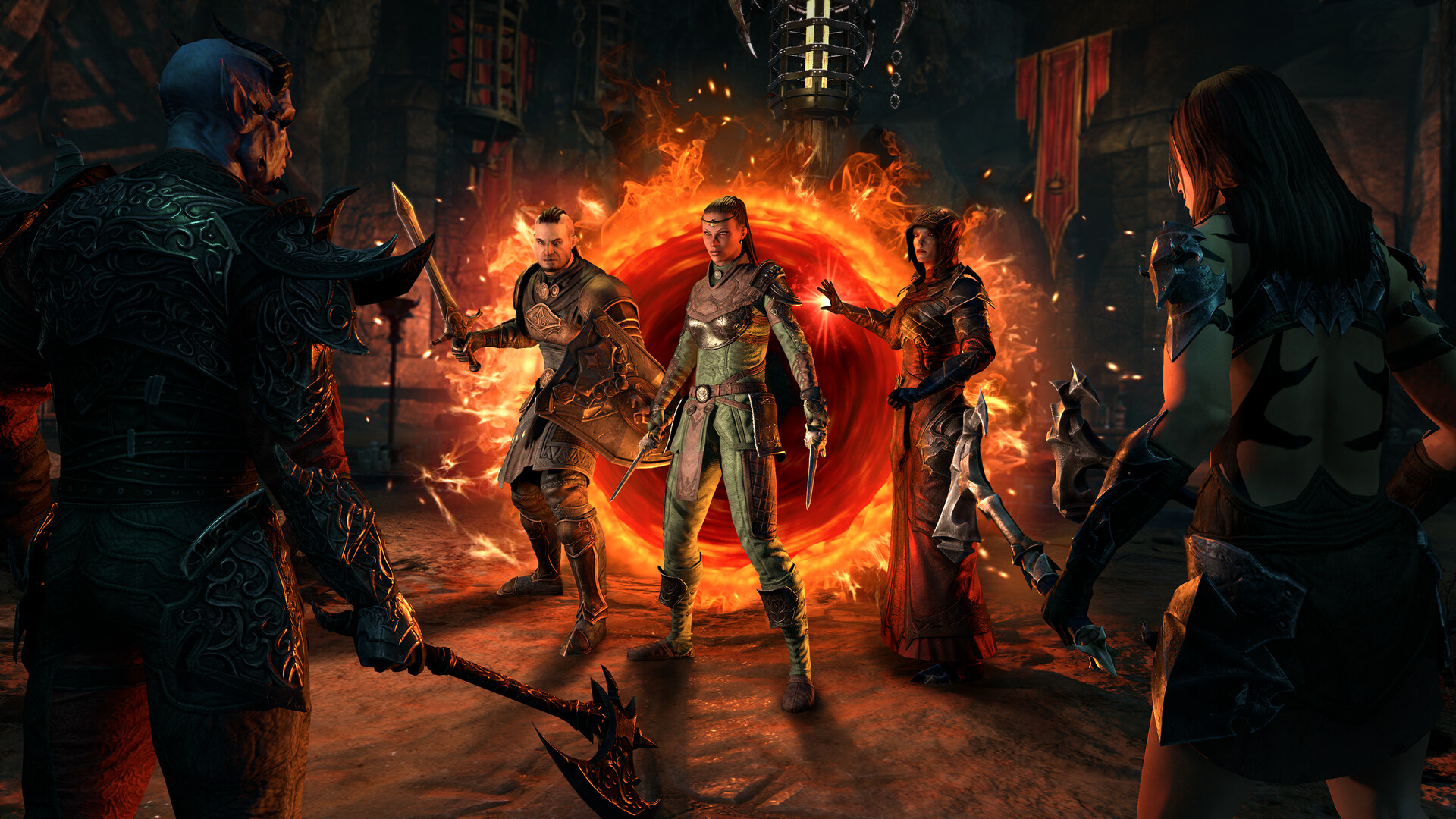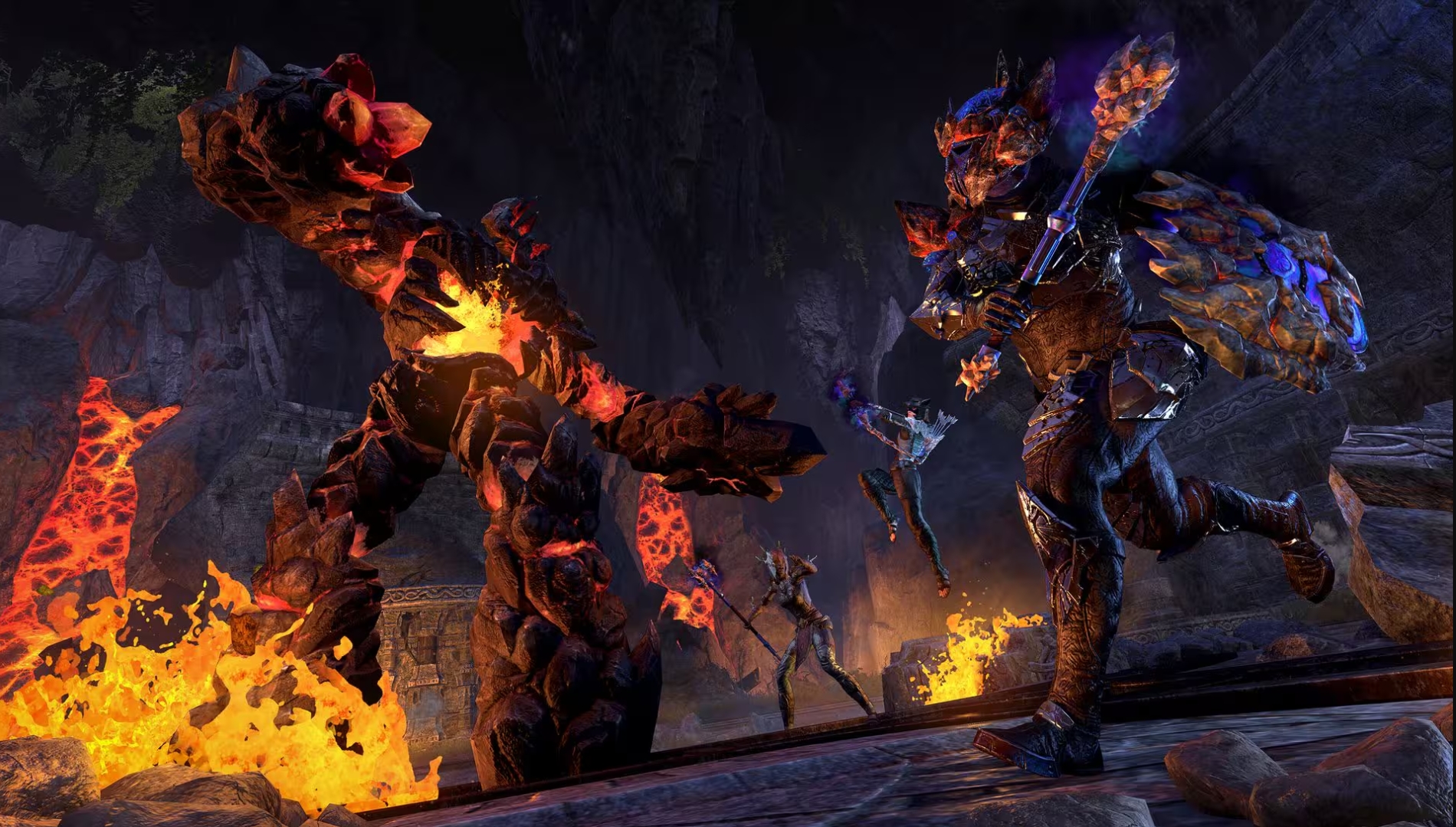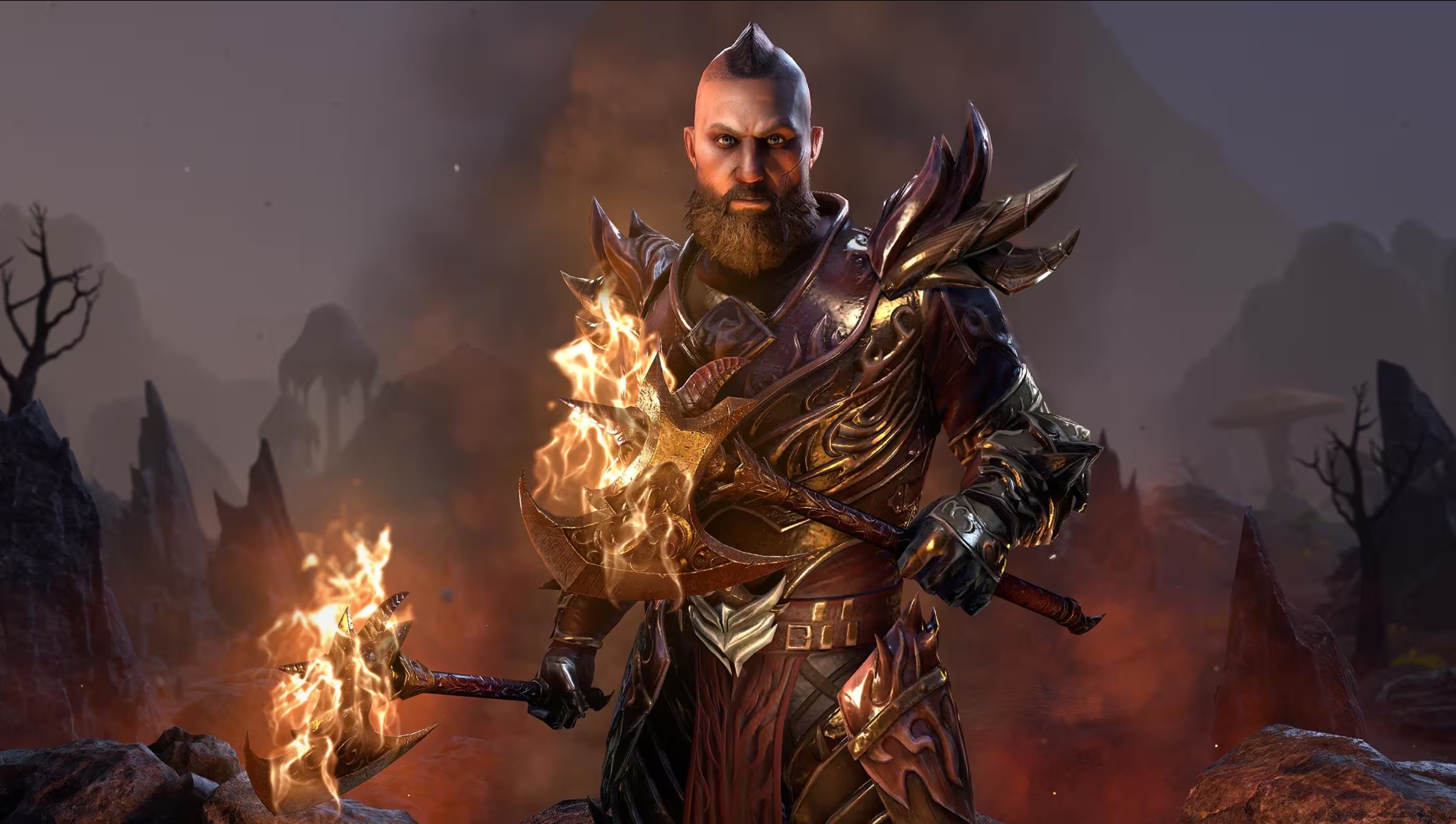Elder Scrolls Online (ESO) Patch 1.4 brought us Dragonstar Arena (DSA) and difficult four player content. Since then, I’ve been playing DSA non-stop. At this point, I’ve beaten Veteran DSA a couple of times and thought it was time to share strategies with other players. So here’s the first part (basics) of a very long series Dragonstar Arena Guide, covering every stage.
Entire DSA Game-Play
DSA Basic Video Guide
Table of Contents
Version
12/8/2014 – Original release
Why Play DSA?
 First off, big thanks to Brick and Solwen for helping me through Vet DSA and sharing their strategies. This guide is possible in large part to them.
First off, big thanks to Brick and Solwen for helping me through Vet DSA and sharing their strategies. This guide is possible in large part to them.
So what is DSA? It’s a 10 Stage four player dungeon. This provides nearly non-stop action, gear drops, achievements and excitement. That’s why you play DSA! This guide’s purpose is to explain the basics and provide a list and links to each stage covered in separate post. I’ll be releasing individual post for various stages as each has a lot of information but you can come back here as I update them and click on Stages for links.
One of the main reasons to run DSA is the phat loots! Here’s some of the items you can expect out of DSA (VR 13 drops from normal and VR 14 drops in Veteran).
Dragonstar Arena Specific Gear
- (2 items) Adds 87 Max Stamina
- (3 items) Adds 4% Weapon Critical
- (4 items)Adds 4% Weapon Critical
- (5 items) Attacking from stealth increases Critical Damage by 15%. Critical Damage increased by 5.0% when not attacking from stealth
- (2 items) Adds 87 Max Magicka
- (3 items) Adds 4% Spell Critical
- (4 items) Adds 8 Spell Damage
- (5 items) Robes of Destruction Mastery Increase maximum Magicka by 6.0% while you have a destruction staff equipped
- (2 items) Adds 131 Max Health
- (3 items) Adds 175 Armor
- (4 items) Adds 175 Spell Resistance
- (5 items) Shieldwork increase block mitigation by 12%
- (2 items) Adds 90 Max Magicka
- (3 items) Adds 12 Magicka Recovery
- (4 items) Adds 8 Spell Damage
- (5 items) Healer’s Habit Increases Healing done by 8%
Master Weapons – separate guide here.
 Achievements and Dye
Achievements and Dye
- Dragonstar Arena Conqueror – Beat Veteran DSA.
- Dragonstar Arena Champion- Beat Normal DSA
- Dye – Adamantine Silver
DSA Basics
DRAGONSTAR ARENA LOCATION
How do we get to DSA? It’s in Upper Craglorn in the northwest part of the map. You can’t directly port there, so you’ll have to get on your horse and ride up. Thankfully, the scenery and entrance is beautiful. Before you port in, make sure you’re on the right mode.
 MODES: NORMAL AND VETERAN
MODES: NORMAL AND VETERAN
There are currently two modes that range in difficulty and mechanics, Normal and Veteran. I recommend Normal mode for beginners or anyone under Veteran Rank 12. Veteran mode can only be done with VR 14 characters and is very challenging. While the stakes are higher in Veteran mode, so is the loot. VR 13 level gear drops in normal mode while the highest level VR 14 only drops in Veteran. Every small bit of resources counts, so farm Vet DSA when you get the hang of it.
PREPARATION
Before entering, make sure you’re ready for the challenge. You don’t need the Best in Slot (BiS) gear though I recommend at least 2,800 health and 3,300 as a tank. We do a general check list prior to entering.
- Alternate Gear – This is optional, but I like to have a secondary set of gear for tanking or DPS that I can switch if someone drops from our group due to issues with connection, family, or life in general. Taking this to the next level, I’ve even got jewelry crafted with fire, ice, and poison resist for each stage. It makes a huge difference though very expensive.
- Food – Make sure you have a couple of pieces of food as this might take over two hours 400+ health is very useful here.
- Potions – I can’t stress enough how important potions can be to your overall performance. Bring tons of potions from variety of resources (as in like 100 per resources). The best are tri-stat potions which provide health, stamina, and magicka though they can be very expensive. If you’re DPS or healer, make sure to bring some weapon/spell power and critical chance increase potions. Again, expensive but worth it.
- Soul gems – Needed for resurrections and weapon charges.
 ROUNDS
ROUNDS
Stages one through nine follow a common theme in terms of rounds, each has five. Only Stage 10 do you have one round which is beating the reigning champion and becoming the new one. As you walk into the arena, you’ll notice the opposite end has a large door that you move through to the next arena via a portal. This arena has cauldrons that will glow blue every time you finish a round within a stage. So if you’re wondering what round you’re on, look towards the exit.
- Round 1 – Round one introduces the enemy and gets you familiar with the theme of the stage.
- Round 2 – This round will introduce a mechanic like poison gas in stage three.
- Round 3 – Another stage that builds on the previous mechanics and adds even more enemies or a mini boss to make things even harder.
- Round 4 – The final wave before the boss and sometimes the most challenging which will test your limits with massive mob pulls.
- Round 5 – The last phase generally involves all the same mechanics plus a boss or two (yeah these are hard).
LENGTH
DSA can be a time commitment. In my very best run (minus a couple of bio breaks), we completed normal in one hour (with no deaths). Veteran on the hand can take four hours to complete. When we finished in the top 10, it only took two hours though everyone had made it to round 10 and were very familiar with the fights.
ROLES AND RESPONSIBILITIES
Damage – Follow the kill order. What this means is a series of priority targets that need to be killed in a specific order to effectively clear the stage. In Stage Eight, the Steamworks, this is very important as two of the four mobs can one-shot your allies. Each player should know the priority “kill” target and call out when they show up. Even if you’re a tank, alerting the DPS to focus on the same target can save your team.
Healer – Heal when convenient (Soren’s Argonian name). What this means is, don’t heal if everyone is at 100% health and in no danger. Damage kills bosses not healing. You’re sole purpose is to optimize the team with speed, resources, or healing. Don’t think your sole job is watching health bars, you’ll need to do damage (and on Stage 10 off-tank).
Tank – Don’t die. You need to be a nasty, sturdy, trusty tank. Yes you can do some damage here and there, but when it comes to crunch time, don’t die. When I’ve been successful tanking, I didn’t have to rely 100% on my healer. I found a way to heal myself through gear, potions, or skills. Optimize your team by pulling targets off the DPS, helping the healer by not standing in red circles, and do damage when threats have been neutralized.
The main thing I’ve learned with these roles is do your job. Don’t over complicate things and stick to what your role is.
Group Composition

I have beaten Normal mode DSA on every character type (Dragonknight, Nightblade, Sorcerer, and Templar) and every role (tank, DPS, and healer). And your group composition or who you bring to the fight makes a huge difference in your planning. With that being said, you can complete this content with any setup though you’ll really have to focus on your strengths vs. weaknesses.
Dragonknight (DK) (Ideal as Tank or DPS)
+ Sturdy and very hard to kill
+ Great utility DPS or tanking (Chains baby!)
– Range is an issue
– Standard of Might only mitigates damage for caster
Nightblade (NB) – (Ideal as DPS)
+ Off-healing damage dealing
+ Veil of Blades is amazing group damage and mitigation ultimate
– Squishy or easy to kill
– Dependent on healers or a Restoration staff for burst heals
Sorcerer (Ideal as DPS)
+ Self-healing with Critical Surge
+ Fast and deadly DPS
– Damage dealing ultimate isn’t that effective
– Relies on outside class abilities
Templar (Ideal as Healer or Tank)
+ Best healing period
+ Group utility machine
– Lower DPS than other classes
– Ultimate cost is a problem
I’ve found two very successful group compositions though make you’re own depending on your situation, guild and friends. Just realize, if you have a heavy DK group, each will need chains to make up for the lack of range. If you bring in a heavy Templar group, you’ll need to time Nova’s for a perfect situation. The player makes the class and I’ve been out DPS’d by a Templar on my DK (so don’t give up on your main!).
Balance Setup – One of each class, DK tank, NB DPS, Sorc DPS, and Templar Healer.
Beast Mode – One Templar Healer, three DKs (DK Tank, two DK DPS).
Stages
Below is the list of stages which I plan to release individually as each has many mechanics, enemies, etc to explain. You can come back to this page when I update one, there will be a hyper link. So make sure you come back!
- Stage One Fighters Guild
- Stage Two Frozen Ring
- Stage Three The Marsh – Work in progress.
- Stage Four The Slave Pit – Work in progress.
- Stage Five The Celestial Ring – Work in progress.
- Stage Six The Grove – Work in progress.
- Stage Seven Circle of Rituals – Work in progress.
- Stage Neigh Steamworks – Work in progress.
- Stage Nine Crypts of the Lost – Work in progress.
- Stage Ten Champion’s Arena – Work in progress.
And that’s Dragonstar Arena basics. I wanted to cover the who, what, why of this content and hopefully you understood. Please feel free to leave me comments or suggestions on this content.
 Reddit
Reddit
 Email
Email








Comments are closed.